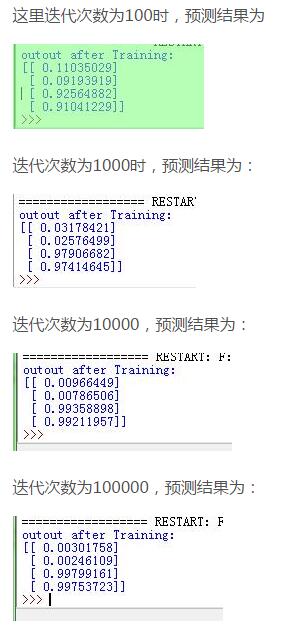溫馨提示×
您好,登錄后才能下訂單哦!
點擊 登錄注冊 即表示同意《億速云用戶服務條款》
您好,登錄后才能下訂單哦!
python實現簡單神經網絡算法,供大家參考,具體內容如下
python實現二層神經網絡
包括輸入層和輸出層
import numpy as np
#sigmoid function
def nonlin(x, deriv = False):
if(deriv == True):
return x*(1-x)
return 1/(1+np.exp(-x))
#input dataset
x = np.array([[0,0,1],
[0,1,1],
[1,0,1],
[1,1,1]])
#output dataset
y = np.array([[0,0,1,1]]).T
np.random.seed(1)
#init weight value
syn0 = 2*np.random.random((3,1))-1
for iter in xrange(100000):
l0 = x #the first layer,and the input layer
l1 = nonlin(np.dot(l0,syn0)) #the second layer,and the output layer
l1_error = y-l1
l1_delta = l1_error*nonlin(l1,True)
syn0 += np.dot(l0.T, l1_delta)
print "outout after Training:"
print l1
import numpy as np
#sigmoid function
def nonlin(x, deriv = False):
if(deriv == True):
return x*(1-x)
return 1/(1+np.exp(-x))
#input dataset
x = np.array([[0,0,1],
[0,1,1],
[1,0,1],
[1,1,1]])
#output dataset
y = np.array([[0,0,1,1]]).T
np.random.seed(1)
#init weight value
syn0 = 2*np.random.random((3,1))-1
for iter in xrange(100000):
l0 = x #the first layer,and the input layer
l1 = nonlin(np.dot(l0,syn0)) #the second layer,and the output layer
l1_error = y-l1
l1_delta = l1_error*nonlin(l1,True)
syn0 += np.dot(l0.T, l1_delta)
print "outout after Training:"
print l1
這里,
l0:輸入層
l1:輸出層
syn0:初始權值
l1_error:誤差
l1_delta:誤差校正系數
func nonlin:sigmoid函數

可見迭代次數越多,預測結果越接近理想值,當時耗時也越長。
python實現三層神經網絡
包括輸入層、隱含層和輸出層
import numpy as np
def nonlin(x, deriv = False):
if(deriv == True):
return x*(1-x)
else:
return 1/(1+np.exp(-x))
#input dataset
X = np.array([[0,0,1],
[0,1,1],
[1,0,1],
[1,1,1]])
#output dataset
y = np.array([[0,1,1,0]]).T
syn0 = 2*np.random.random((3,4)) - 1 #the first-hidden layer weight value
syn1 = 2*np.random.random((4,1)) - 1 #the hidden-output layer weight value
for j in range(60000):
l0 = X #the first layer,and the input layer
l1 = nonlin(np.dot(l0,syn0)) #the second layer,and the hidden layer
l2 = nonlin(np.dot(l1,syn1)) #the third layer,and the output layer
l2_error = y-l2 #the hidden-output layer error
if(j%10000) == 0:
print "Error:"+str(np.mean(l2_error))
l2_delta = l2_error*nonlin(l2,deriv = True)
l1_error = l2_delta.dot(syn1.T) #the first-hidden layer error
l1_delta = l1_error*nonlin(l1,deriv = True)
syn1 += l1.T.dot(l2_delta)
syn0 += l0.T.dot(l1_delta)
print "outout after Training:"
print l2
import numpy as np
def nonlin(x, deriv = False):
if(deriv == True):
return x*(1-x)
else:
return 1/(1+np.exp(-x))
#input dataset
X = np.array([[0,0,1],
[0,1,1],
[1,0,1],
[1,1,1]])
#output dataset
y = np.array([[0,1,1,0]]).T
syn0 = 2*np.random.random((3,4)) - 1 #the first-hidden layer weight value
syn1 = 2*np.random.random((4,1)) - 1 #the hidden-output layer weight value
for j in range(60000):
l0 = X #the first layer,and the input layer
l1 = nonlin(np.dot(l0,syn0)) #the second layer,and the hidden layer
l2 = nonlin(np.dot(l1,syn1)) #the third layer,and the output layer
l2_error = y-l2 #the hidden-output layer error
if(j%10000) == 0:
print "Error:"+str(np.mean(l2_error))
l2_delta = l2_error*nonlin(l2,deriv = True)
l1_error = l2_delta.dot(syn1.T) #the first-hidden layer error
l1_delta = l1_error*nonlin(l1,deriv = True)
syn1 += l1.T.dot(l2_delta)
syn0 += l0.T.dot(l1_delta)
print "outout after Training:"
print l2
以上就是本文的全部內容,希望對大家的學習有所幫助,也希望大家多多支持億速云。
免責聲明:本站發布的內容(圖片、視頻和文字)以原創、轉載和分享為主,文章觀點不代表本網站立場,如果涉及侵權請聯系站長郵箱:is@yisu.com進行舉報,并提供相關證據,一經查實,將立刻刪除涉嫌侵權內容。